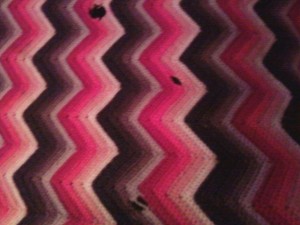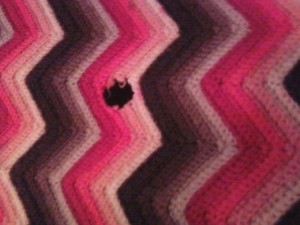Mending Crochet
By A Guest Writer – 13 Comments| A Guest Post by Laura Biondi.
Last week, I found out that my mom used to crochet. I have been crocheting for five years and she never told me! But when I started working on an afghan, it all came out. Her grandmother taught her, and had made my mom a beautiful afghan that she still had. She pulled it out to show me, but we were both so upset to find that moths (or time) had eaten three big holes in it. My poor mom was heartbroken! I would love to mend this beautiful heirloom for her, but of course I don’t know what stitch, hook size, or yarn my great-grandmother used, so I have no idea how to begin repairs! One of the holes is between two rows, but the others are just big gaps in the pattern. If anyone has any tips to offer me on how to patch or repair this afghan, please comment below! |




Try asking the Crochet Corner column over at Ravelry! I think I’ve seen a tutorial there on how to fix granny squares, so maybe she would know how to fix this too. Good luck! And be sure to come back and post again when you figure it out!
I have repaired a hole like your large one before. My dog tore it. I took it to the sewing machine and sewed around the hole to keep it from unraveling. Then I attached the yarn to the the sewn line and began to crochet back into the pattern. After that just weave in the ends as you would any pattern. As for the size hook that was used I would make a few swatches with different size hooks until you can match the size stitch in the afghan. I think you may have more trouble matching the yarn color though. Good luck.
I actually don’t have experience mendig crocheted projects, but what cathy said I think is a great idea, and cuz you say you’ve been crochetting for 5 years I think you have some projects that can be useful to see what kind of hoog your gran grand mother used, so try it, if you do the sewing machine thing you’ll make an even more special afghan.
Hope this is useful and Good luck. (:
If you can’t find matching yarn. You can always do the fill in with something close, then put flowers, flutterbies or some other applique on top to hide it. HTH
I recommend that you pay a visit to that blog (http://sunshinescreations.vintagethreads.com) . On the right side bar,under “Labels:Tags” you will find “Repair work”,which shows some examples and tutorials on that matter.I hope that they can help you.
you might be able to do foundation single crochet across the big gap, and then sew it in.
For matching yarn, take a close look at the ends. You might be able to ‘unravel’ a row or two, and use that yarn for the repair. I’ve done that before when I had to match up yarn but couldn’t find it. A row or two is not missed, and gives you a true match with the same wear level.
i read cathy’s advice above and i though you could do an applique maybe in a square shape (2 front & back) and then add a flower on it or you could embroider a design also on it ,and sew it covering the wholes in such a way that looks good to the eye , and i mean knowing how things get pass on specially heirlooms , i think your mom will appreciate your effort and it will increase the sentimental value because you her daughter did the fixing …i dont know i though if it will be me i will be happy with that :).
cheers!
Hi Laura. I’m certainly not a “master mender” but I looking to the ends of the blanket for usable repair yarn as Melissa wrote is a good start, especially since it looks like you’d only have to rip out 4 rows to have enough of each color. Unraveling a few rows to save the entire blanket sounds like a good trade off to me. For the smaller holes, it might even work to “darn them” with a needle by sewing them up tight with a bit of the salvaged yarn. If you could get away with that and have it look relatively intact, that is what I would do with the small holes. As for the hole that spans a few rows, I’d do my best to mend it in pattern stitch. Examine the blanket, which is obviously a ripple. From the photos it looks like single crochet worked in either all front loops or all back loops, as it seems to have a ridge. Could be the photo, of course. If you are unsure, ask someone who has been crocheting a while longer as it may be you have not worked this pattern before. Most likely, it was a worsted and a G hook, as so many ripples are. Look to the internet for a ripple pattern. This one is a sharply pointed ripple. Google crochet ripple images and you’ll definitely find a pattern to assist you. I would unravel the yarn around the big hole to the point where there was no more unraveling and weave the ends in to their corresponding colors. I would then reattach usable yarn harvested from the ends as if to change colors…no knots…and begin in pattern stitch…which if it is single crochet….that is what I’d do for the first color, and when you get to the peak, you follow the ripple pattern and PROBABLY make 3 scs into one stitch….and when you get to the valley it is a decrease or a skipped stitch. After the repair of that row is complete, I’d fasten off and weave in the end and attach the next color, etc. until done. The blanket is already ruined…you have nothing to lose by trying to put it back together. Anything done will look better than holes.
My sis in law had lovely Xmas stockings that her grandmother had made….they somehow got “eaten”, and I was able to fix them in pattern because I was familiar with the pattern and I did pull back some of the yarn from the top in order to use it for the repair. Good luck. Donna Carlen
I’ve had a similar experience with a knitted blanket that belonged to my husband’s aunt. It was given to her by a very good friend who had passed away and made in coordinating earthtone wool rectangles. I did not knit at the time, but she asked me to repair it whichever way I could. I darned over the holes with the closest match I could and then appliqued some crochet butterflies and bumblebees over the spots and in a few other places to make it look planned. She was very pleased with the end result and the blanket was still very usable and able to be displayed on the armchair it had always been kept on.
The only problem I see with unraveling back to get to the yarns you might need is if the dark colors are at the end. If so, you’re unreaveling several rows that you could not reuse. That might change the proportions of the blanket enough to make it look odd.
Good luck and enjoy the process.
I have a gorgeous crocheted top that has a fairly decent-sized hole in the front of it. I bought yarn to repair it but I have no idea where/how to start. Maybe I should take a photo of it and post it here?
I’m working on a family afghan with a similar problem, but more complex. It has several dozen hole that suddenly appear after it was washed, apparently because the yarn simply wore out. Impossible to take yarn from the ends since there are six colors and all are affected. I’ve been looking at it for a year, not sure how to proceed. I recently discovered some waxed silk thread hidden away in the back of a closet that is probably as old as the afghan and miraculously, there are colors nearly identical to the afghan. I’m beginning with the smallest holes and sort of “whipping” the rows together and I’m thrilled with the results to far. If you look really hard you can tell where it’s been mended, but gosh, who would expect a 60+ year old afghan to be in perfect shape?
My friend asked me to fix her son’s afgan. It has a huge hole and some smaller ones. It was crocheted by his Great Grandmommy . Would you suggest that I try to crochet it with a crochet hook? And how would you suggest I do this?
Thank You,
Judy